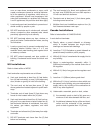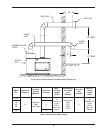
22
Table H: Venting Category Requirements
Combustion Air
Supply
Exhaust
Configuration
Venting Category
Certified
Appliance Material
Combustion Air
Inlet Material
From Inside
Building (Non-Direct
Venting)
Vertical Natural
Draft Venting
I
Type B or and
Category I Venting
System*
Horizontal
Thru-wall
Venting
III
Stainless Steel
(Gas Tight)
From Outside
Building (Direct
Venting)
Vertical Venting I
Type B or and
Category I Venting
System*
Galvanized Steel
PVC
ABS
CPVC
Horizontal
Thru-wall
Venting
III
Stainless Steel
(Gas Tight)
*As defined in the latest edition of the NFGC, or in Canada, the B149.
Barometric Damper
A barometric damper may be required when vent
heights exceed 25 feet or when the draft is greater
than -0.08 in. WC. In these installations, a barometric
damper (single acting) is recommended.
The damper should be installed NO CLOSER than 18
in. from the discharge of the unit and no closer than 18
in. from a combustible ceiling. The damper can be
installed in horizontal or vertical runs of vent pipe as
necessary. Installation in a bull-head tee is acceptable
as shown in the NFGC.
The weights on the damper should be adjusted per the
damper manufacturer’s instructions for proper opera-
tion.
Support of Vent Stack
The weight of the vent stack or chimney must not rest
on the heater vent connection. Support must be pro-
vided in compliance with applicable codes. The vent
should also be supported to maintain proper clear-
ances from combustible materials.
Use insulated vent pipe spacers where the vent pass-
es through combustible roofs and walls.
Vent Terminal Location
General
Give special attention to the location of the vent termi-
nation to avoid possibility of property damage or
personal injury.
a) Gases may form a white vapor plume in winter.
The plume could obstruct a window view if the ter-
mination is installed in close proximity to windows.
b) Prevailing winds could cause freezing of conden-
sate and water/ice build-up on building, plants or
roof.
c) The bottom of the vent terminal and the air intake
shall be located at least 12 in. above grade.
d) Un-insulated single-wall metal vent pipe shall not
be used outdoors on cold climates for venting gas
utilization equipment.
e) Through-the-wall vents for Category II and IV
appliances and non-categorized condensing appli-
ances shall not terminate over public walkways or
NOTE: During winter months check the vent cap
and make sure no blockage occurs from build up of
snow. Condensate can freeze on the vent cap.
Frozen condensate on the vent cap can result in a
blocked flue condition.


















